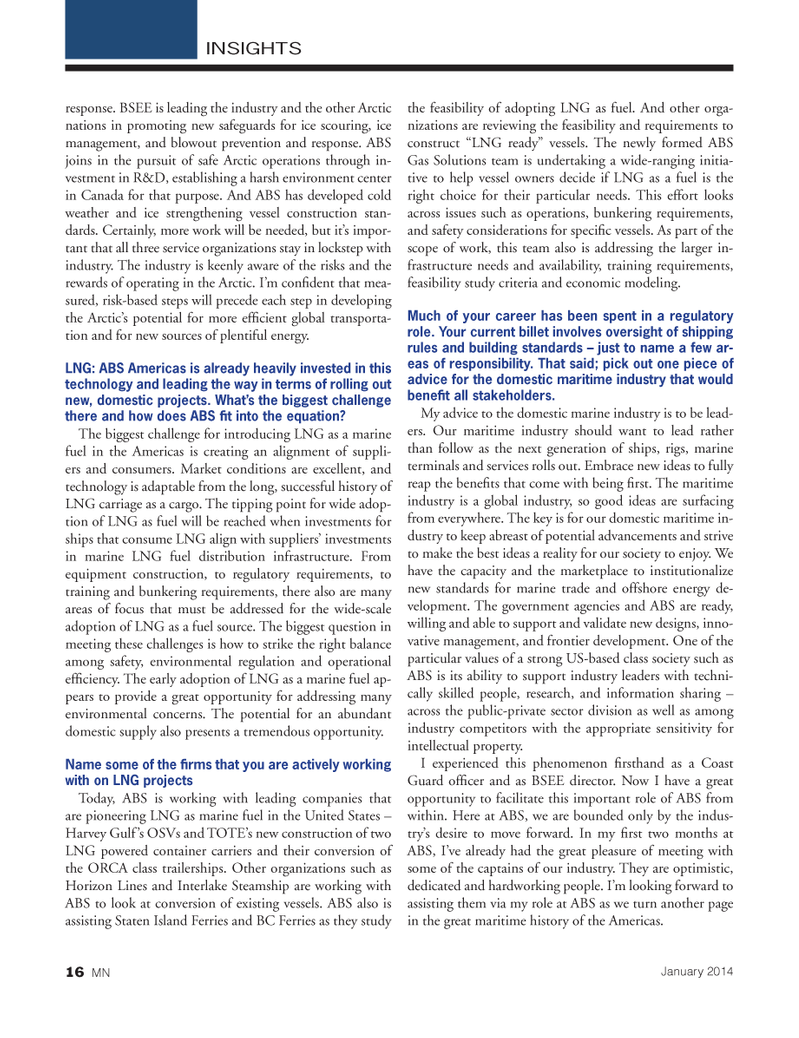
Page 16: of Marine News Magazine (January 2014)
Tug Boat Technology
Read this page in Pdf, Flash or Html5 edition of January 2014 Marine News Magazine
INSIGHTS response. BSEE is leading the industry and the other Arctic nations in promoting new safeguards for ice scouring, ice management, and blowout prevention and response. ABS joins in the pursuit of safe Arctic operations through in- vestment in R&D, establishing a harsh environment center in Canada for that purpose. And ABS has developed cold weather and ice strengthening vessel construction stan- dards. Certainly, more work will be needed, but it’s impor- tant that all three service organizations stay in lockstep with industry. The industry is keenly aware of the risks and the rewards of operating in the Arctic. I’m confi dent that mea- sured, risk-based steps will precede each step in developing the Arctic’s potential for more effi cient global transporta- tion and for new sources of plentiful energy.
LNG: ABS Americas is already heavily invested in this technology and leading the way in terms of rolling out new, domestic projects. What’s the biggest challenge there and how does ABS fi t into the equation?
The biggest challenge for introducing LNG as a marine fuel in the Americas is creating an alignment of suppli- ers and consumers. Market conditions are excellent, and technology is adaptable from the long, successful history of
LNG carriage as a cargo. The tipping point for wide adop- tion of LNG as fuel will be reached when investments for ships that consume LNG align with suppliers’ investments in marine LNG fuel distribution infrastructure. From equipment construction, to regulatory requirements, to training and bunkering requirements, there also are many areas of focus that must be addressed for the wide-scale adoption of LNG as a fuel source. The biggest question in meeting these challenges is how to strike the right balance among safety, environmental regulation and operational effi ciency. The early adoption of LNG as a marine fuel ap- pears to provide a great opportunity for addressing many environmental concerns. The potential for an abundant domestic supply also presents a tremendous opportunity.
Name some of the fi rms that you are actively working with on LNG projects
Today, ABS is working with leading companies that are pioneering LNG as marine fuel in the United States –
Harvey Gulf’s OSVs and TOTE’s new construction of two
LNG powered container carriers and their conversion of the ORCA class trailerships. Other organizations such as
Horizon Lines and Interlake Steamship are working with
ABS to look at conversion of existing vessels. ABS also is assisting Staten Island Ferries and BC Ferries as they study the feasibility of adopting LNG as fuel. And other orga- nizations are reviewing the feasibility and requirements to construct “LNG ready” vessels. The newly formed ABS
Gas Solutions team is undertaking a wide-ranging initia- tive to help vessel owners decide if LNG as a fuel is the right choice for their particular needs. This effort looks across issues such as operations, bunkering requirements, and safety considerations for specifi c vessels. As part of the scope of work, this team also is addressing the larger in- frastructure needs and availability, training requirements, feasibility study criteria and economic modeling.
Much of your career has been spent in a regulatory role. Your current billet involves oversight of shipping rules and building standards – just to name a few ar- eas of responsibility. That said; pick out one piece of advice for the domestic maritime industry that would benefi t all stakeholders.
My advice to the domestic marine industry is to be lead- ers. Our maritime industry should want to lead rather than follow as the next generation of ships, rigs, marine terminals and services rolls out. Embrace new ideas to fully reap the benefi ts that come with being fi rst. The maritime industry is a global industry, so good ideas are surfacing from everywhere. The key is for our domestic maritime in- dustry to keep abreast of potential advancements and strive to make the best ideas a reality for our society to enjoy. We have the capacity and the marketplace to institutionalize new standards for marine trade and offshore energy de- velopment. The government agencies and ABS are ready, willing and able to support and validate new designs, inno- vative management, and frontier development. One of the particular values of a strong US-based class society such as
ABS is its ability to support industry leaders with techni- cally skilled people, research, and information sharing – across the public-private sector division as well as among industry competitors with the appropriate sensitivity for intellectual property.
I experienced this phenomenon fi rsthand as a Coast
Guard offi cer and as BSEE director. Now I have a great opportunity to facilitate this important role of ABS from within. Here at ABS, we are bounded only by the indus- try’s desire to move forward. In my fi rst two months at
ABS, I’ve already had the great pleasure of meeting with some of the captains of our industry. They are optimistic, dedicated and hardworking people. I’m looking forward to assisting them via my role at ABS as we turn another page in the great maritime history of the Americas.
January 2014 16 MN
MN JAN14 Layout 1-17.indd 16 12/20/2013 10:03:37 AM

 15
15

 17
17
